Peter Pan
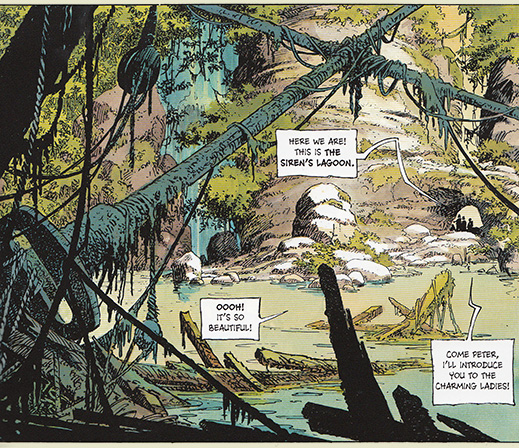
Sometimes, though not often, Peter had dreams, and they were more painful than the dreams of other boys. For hours he could not be separated from these dreams, though he wailed piteously in them. They had to do, I think, with the riddle of his existence.
In preparation for reviewing Régis Loisel's Peter Pan, I thought it necessary to show due diligence by reading J.M. Barrie's novel, Peter and Wendy. I'm glad I did. Not only is Barrie a fantastic writer with a grand taste for words (and the worlds their interplay can invoke), but I found the opportunity to have my conception of Pan entirely overturned. I, like too many others, have had my entire familiarity with the character dictated by the sanitized Disney product.11And in my case, it's not even the full-fledged Disney product. I made my initial acquaintance with Peter Pan through the Disney storybook record, an album with an attached ten-or-so-page picture book that tracked along with an abbreviated retelling of the movie. That always felt acquaintance enough for me.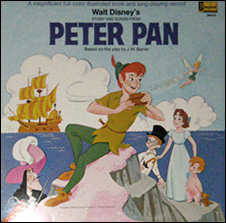
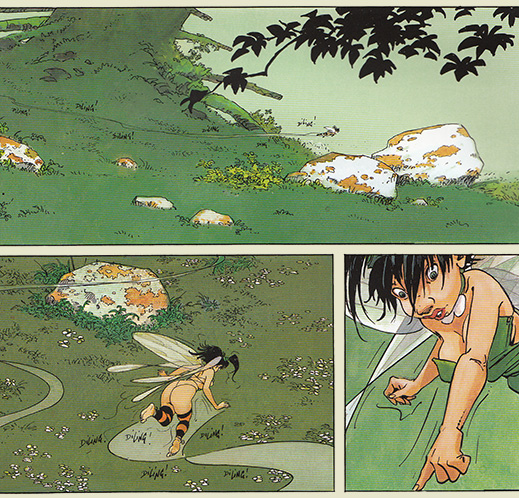
Most of us are familiar with Disney's penchant for trimming and reframing classic stories into confections made palatable for audiences in the lowest common denoninator (in this particular case, terrified moralists22Those who find violence and sexuality and bad opinion to be in that realm of things unconscionable to present for children's consumption.). Under Disney's pen, Hans Christian Anderson's littlest mermaid does not lose her tongue, does not walk with excruciating pain, is not tempted to murder, and does not perish in the end. Disney's Pinocchio does not kill the talking cricket at the beginning of the story. Victor Hugo's finale doesn't end in a litany of death with Disney at the helm. The stories of Cinderella, Snow White, Sleeping Beauty, Pocahontas, Aladdin—all paved over, gently landscaped, tidied, and made wholesomely presentable by the Disney company. Some of these stories survive their crisp evolution and become their own wonderful selves in a kind of cinematic afterlife. Others, like Peter Pan, fair less well. Not only does the story lose Barrie's ingenious narration, the chief and principal joy of the book, but Pan's character and world are eviscerated, losing all of the frightening terrifying heart that makes Barrie's story so wonder-strikingly perfect. I'm actually somewhat upset at Disney for turning such a work of beauty into the anemic sort of innocuous adventure we find in their Peter Pan. Their version kept me from reading the original for more than three decades.
It's fortunate that I had begun Peter and Wendy before embarking on Loisel's journey with the character. Had I not, I would have been broadsided entirely by a crass, violent, sexist, and sexual vision of Peter Pan that stands strikingly at odds with Disney's depiction. I would have chalked the book up as merely yet one more of the revisionist trend of reconceptualizing faerytales into dark, modernized treats for the Cynical Generation.33Shoutout to muh peeps. While reframing classic stories to be "more realistic" was cool for a while, it's been done and redone and overdone so many times that it's passed well into the realm of cliché by now. Adding to Disney's sins, they almost had me believing that Loisel's take on Peter was typically revisionist. But it's not—not at all. Rather, it's probably more properly viewed as devotional. It'd be counted fanfiction save for its production value and narrative strength.
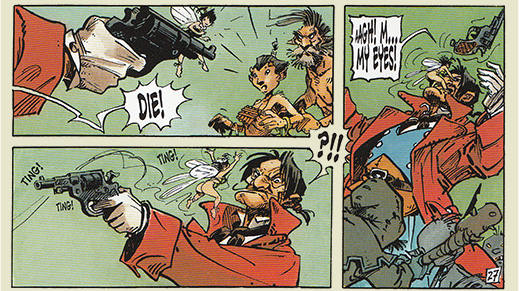
Loisel's origin story for Pan susses out so many of the terrible little deviancies that Barrie's Peter and Wendy coyly includes. Barrie's story took place in a world of violence and sex and anger and depravity, but Barrie consciously told his tale in a manner fitting for young listeners. It's a deeply whimsical work, subversive in how baldly it glosses the depravities at stake in Peter's world. Via Peter and Wendy, we find numerous dark surprises. Peter kills off Lost Boys as they grow too old for his taste. The Redskins are naked save for a decoration of scalps, some belonging to the Pirates, some belonging to Lost Boys, and their chief is so thoroughly overburdened with such decorations that he has difficulty sneaking. Tinker Bell conspires to have Wendy assassinated by a Lost Boy (with an arrow to the chest) and is successful until it is revealed that a bare chance caused the arrow to glance from her heart. Tinker Bell is portrayed as a bit of the sexpot, endowed with a generous bosom and wearing a scant leaf as a dress in order to best show off her figure. The faeries are a randy bunch and given to orgies. Peter has a fondness for meting out mortal violence. Barrie recounts that Peter will come home with stories of great adventures—only in the light of day no body can be found; at other times he will come home with no story at all—yet come daylight, we find a corpse in plain sight. Hook routinely murders his crew members for various slights and perceived slights. In Wendy, John, and Michael's flight from London to Neverland, the journey is so long that Michael falls asleep and plunges from the air toward death in the waves below; Peter dives and rescues him spectacularly at the last moment, but Wendy suspects that Peter is indifferent to the saving of Michael's life and wouldn't have bothered save for the fact that he could look heroic doing it. Neverland drains its inhabitants of their memories and so Wendy and the boys begin to forget their former lives, but Peter, who's been there longest, has no memory of his former life nor of many other things. Wendy continually must remind Peter of who she is. When Tinker Bell finally dies, Peter quickly forgets that she ever existed.
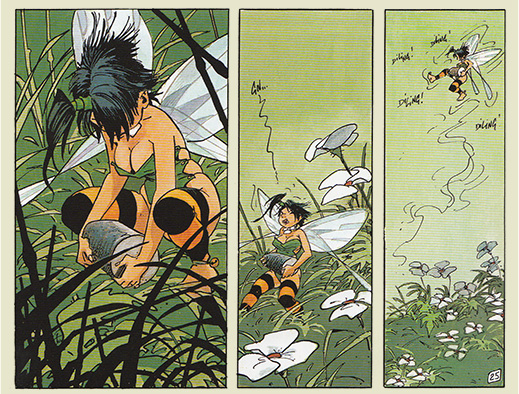
Had I not discovered that this was the character and realm that Loisel needed to build toward, I would not have been able to understand his work for what it is. Loisel's Peter is not yet the Pan that Barrie would reveal to the world, but he's on his way—and unlike Barrie, Loisel does not have any reason to hold back the grim clouds inherent in Peter's tale. Barrie's story is a gathering of light in a world of profane darkness; Loisel's is the story that justifies Barrie's requirement of light. To that end, Loisel crafts a visual narrative that capitalizes on an adult readership—and the grown-ups (parents, uncles, aunts, grandparents, and teachers) who take the time to investigate Loisel's Peter Pan will find themselves at a place to better understand Barrie's original, as well as the profound need for Barrie's steadied voice from within that maelstrom.44Barrie perhaps even gives those of us who are parents to small children a couple recommendary signposts for how to navigate our discussion of the Real World with the small, ingenious, and darting minds in our charge.
While Barrie's Peter is grounded in Edwardian England, this prequel is founded a quarter-century earlier in a Victorian London more reminiscent of the filthy streets of Dickens than the drawing-room comedies of Oscar Wilde. Loisel's London is dirty and sinister, on the cusp of reeling under the terrible shadow of the Ripper. The city is rife with whores and pedophiles and thieves and drunks. It's a world of foul deeds and befouled hearts. And it's here that we first find Peter, not quite fortunate enough to be an orphan. Through six meaty chapters Loisel helps Peter divest himself of his memory, his person, his humanity—all to the end that he might become Barrie's eternal child-monster.
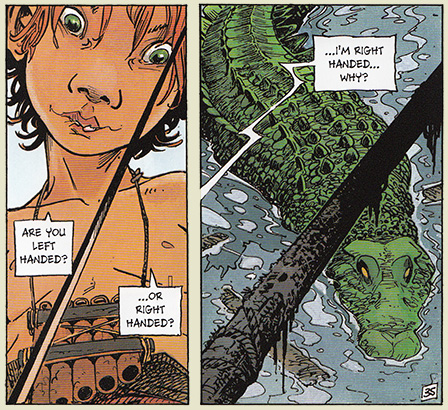 Whimsical vengeance.
Whimsical vengeance.
As a writer, Loisel's panels are wordy—in the sense that there are many words—but I've never had the aversion to verbose comics that some do. More importantly, Loisel writes an arc for Peter that rarely feels false. We know where Peter's going to end up but we wonder how the French creator is going to get him from Point A to Point B. And not just from London to Neverland, but from Peter the very human child in despair and poverty to Peter the heartless, innocent child of faeries and whimsy. Loisel is solid in his characterization and in explaining all the bits that Barrie left undemanded and unstated.
But as good as Loisel is in his writing, his real talent lies in his illustration. He's tremendously creative in his sense of framing within panels. Every page is bursting with dynamism and life. London is dark and desaturated, as you can imagine. It looks as filthy as it is in its Victorian heart. Neverland is bright, shockingly colourful, and designed for adventure.55As murderous and sinister as those adventures might be.
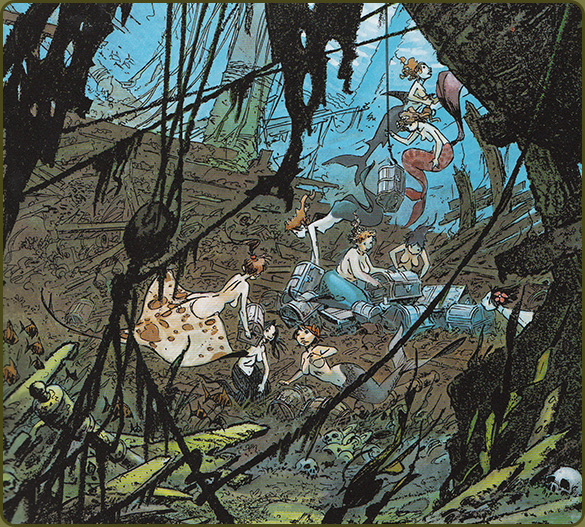 What blows me away in this panel is that these mermaids are not just all
What blows me away in this panel is that these mermaids are not just all
standard fish-tailed. One has the bottom half of a shark. Another has the
bottom half of a manta ray. I had never considered the remotest possibility of that.
Note also: I've edited the nipples out of this to make the nudity more
coy and pg-13-ish, Akamatsu-style. For reasons.
Beyond page-and-panel construction and environmental concerns, most readers are going to take notice of Loisel's character design and figurework. Peter and Hook and Tiger Lily and Tinker Bell and the Redskins and Pirates and faeires and Londoners all are strongly, iconically conceived. Their features are cartoony, but that helps their ability to convey their passions in a way the reader can apprehend even without concern for the texts they nestle up against.
There will likely be some objection to Loisel's depiction of the Black Pirate and the Redskins. Some very understandable objection. The Black Pirate features the horrible visual stereotyping we find in nineteenth- and early-twentieth-century depictions of Africans in Western media, from Little Black Sambo to the native savages in Tintin and Little Nemo. The Redskins of the Piccaninny Tribe are indistinguishable from each other and all look like caricatures of Magua from the Daniel Day Lewis Last of the Mohicans, or maybe leaner meaner versions of Looney Toons' Injun Joe. Outside their context within the island's mythology, the figures are, I'd wager, an indefensible outrage from any creator in the last thirty years.

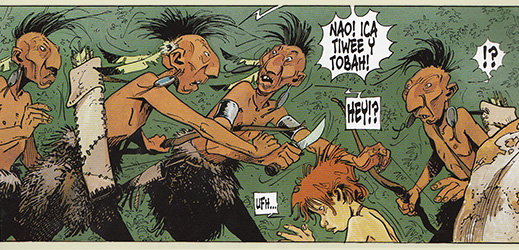
However, and I say this delicately, I think their offensive nature makes sense within the scope of Neverland and the imaginative fabric from which both Barrie and Loisel cut their cloth. Neverland is, in canon, the product of imaginations. In Barrie, Neverland is fashioned of the dreams of the people who dream it. And, it should be noted, there is not just one Neverland. That which we witness in Peter and Wendy is at least the product of Peter, Wendy, John, Michael, and the Lost Boys.66There is evidence of other voices making decisions over Peter's Neverland (such as when the decisions of a few faithful sleepers and dreamers determine the fate of Tinker Bell in her hour of need). But they seem limited both in number and power. But principally, its details are fashioned by the magic of Peter himself. The land wakes and sleeps upon his comings and goings. In Loisel, I believe we find that Hook's imaginations and dreams fuel the make-up of Peter's Neverland as well.
Because this Neverland is constructed of the thoughts and beliefs of late-nineteenth- and early twentieth-century Caucasian Londoner children, it seems reasonable to presume that their fantasy conception of what they imagined to be the wild races would appear to resemble the grotesques we find in the literature of the time. Peter would likely have never seen a Native American, so his vision of them would have been strictly limited to the literary depictions of his age. And though he would have almost certainly encountered black men and women, people (not even just children) show an unhealthy resilience to giving up the stereotyped caricatures that fill the racial propaganda of any era. I think it reasonable to conclude Peter's dreamworld creation of blacks and Native Americans would reflect the adventure serials of his day. Despite the distastefulness of the imagery, I think it speaks to the verity of Loisel's adaptation.77If nothing else, it should stand as a reminder to those of us with children that the dishonest bigotries we weave into our own storytelling to the children in our charge can shape their lives in negative ways for years to come.
Additionally, the story of Peter Pan has always proved an awkward place for women. Madonnas, mothers, and whores, across the board. In the Neverland conception of things, one can be the gentle-and-soft mother (e.g. Mrs. Darling, the storyteller), the guileless maiden to be rescued (e.g. Tiger Lily), or the seductress (the mermaids). Wendy, confounding Peter consistently throughout the story and ultimately shattering his peace and routine, occupies all three parts, playing the virginal mother who seeks to tempt Peter from Neverland, the fortress of his innocence. Loisel attempts to lay some groundwork for Peter's method of categorizing and, I think, he does a fair job. The women of London are universally vile, his mother included.88And lest Loisel come under charge of misogyny here, it should be pointed out that every adult figure (save one) is reprobate. Peter is sexually harassed by a woman and then pages later nearly raped by a man. And both men and women prompt Peter to expose himself for money, proving the disgusting nature of his social environment en toto. He is surrounded by whores and drunks. He longs for female purity but sees adult living as filthy as the lives around him demonstrate it to be. It works for a kind of psychological background for the character, but I'm still debating with myself at how deeply Loisel dips his toe into cliché on this point.
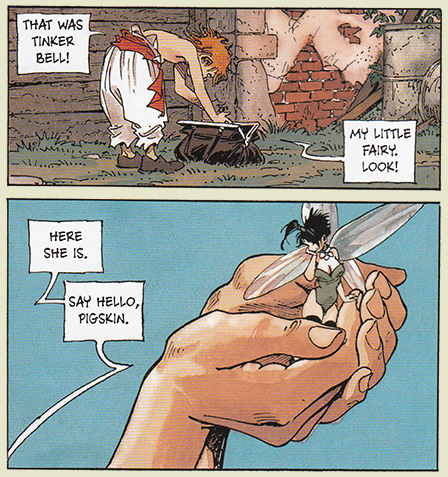
Really, one of the best ideas at play in Loisel's Peter Pan is having Peter travel back and forth between London and Neverland. The terrors of one inform the terrors of the other and the diminishing returns on the pleasures he finds in London reinforce his eventual fate as the eternal boy finding refuge past the second star on the right and straight on 'til morning. As Peter's ties to the real world dwindle through death, displacement, and dissipation, he leaves behind a London that is becoming grislier and grislier by the year. Women in increasing numbers lie butchered in the streets from an unknown culprit even as Peter's fortunes in Neverland rise. His reputation soars on the island and his ability to engage in constant adventure is secured. All the elements are in place for the status quo at which Barrie will find the character twenty years later. The origin is set and Loisel's work is done.
Peter Pan is a book of fervent imaginations and the darkest of doings. It won through my skepticism with astonishing ease. The book is wonderful and horrible and I cannot imagine a more perfect prequel to Barrie's mythology.
"Do you believe?" Peter cried. Many clapped. Some didn't. A few little beasts hissed.
I was hesitant to believe. I was ready to hiss. But I didn't. Instead, I believed. And I clapped. Loisel won me over. I'm still clapping.
Good Ok Bad features reviews of comics, graphic novels, manga, et cetera using a rare and auspicious three-star rating system. Point systems are notoriously fiddly, so here it's been pared down to three simple possibilities:
3 Stars = Good
2 Stars = Ok
1 Star = Bad
I am Seth T. Hahne and these are my reviews.
Browse Reviews By
Other Features
- Best Books of the Year:
- Top 50 of 2024
- Top 50 of 2023
- Top 100 of 2020-22
- Top 75 of 2019
- Top 50 of 2018
- Top 75 of 2017
- Top 75 of 2016
- Top 75 of 2015
- Top 75 of 2014
- Top 35 of 2013
- Top 25 of 2012
- Top 10 of 2011
- Popular Sections:
- All-Time Top 500
- All the Boardgames I've Played
- All the Anime Series I've Seen
- All the Animated Films I've Seen
- Top 75 by Female Creators
- Kids Recommendations
- What I Read: A Reading Log
- Other Features:
- Bookclub Study Guides










